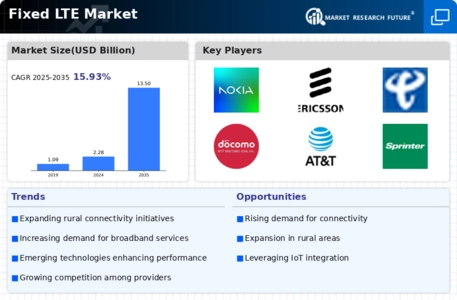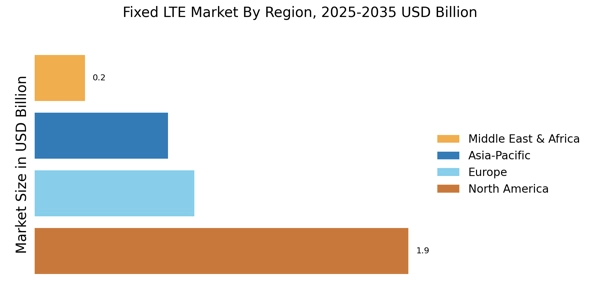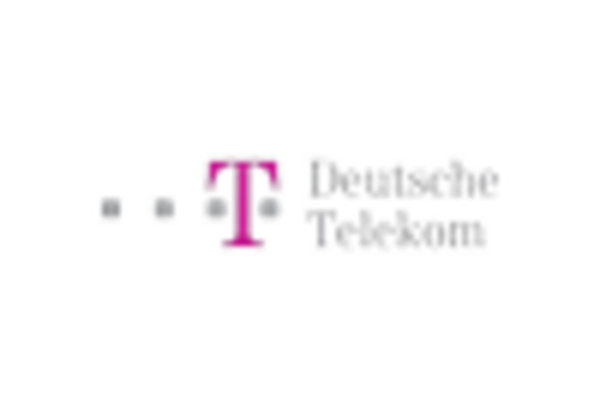Competitive Pricing Strategies
Competitive pricing strategies are emerging as a key driver in the Fixed LTE Market. As more providers enter the market, the competition intensifies, leading to a variety of pricing models aimed at attracting consumers. This trend is particularly evident in regions where multiple service providers offer Fixed LTE solutions, resulting in price reductions and enhanced service packages. Recent market analysis indicates that pricing for Fixed LTE services has decreased by approximately 15% over the past year, making it a more accessible option for consumers. The Fixed LTE Market is likely to continue experiencing this trend, as providers strive to differentiate themselves through competitive pricing and value-added services. This dynamic environment not only benefits consumers but also stimulates further investment in infrastructure and service improvements.
Increasing Internet Penetration
The Fixed LTE Market is experiencing a notable surge in demand due to the increasing internet penetration across various regions. As more households gain access to the internet, the need for reliable and high-speed connectivity becomes paramount. According to recent data, internet penetration rates have reached approximately 60% in many areas, indicating a substantial market opportunity for Fixed LTE services. This trend is particularly pronounced in developing regions, where traditional broadband infrastructure may be lacking. The Fixed LTE Market is poised to capitalize on this growing demand, as consumers seek alternatives that offer both speed and reliability. Furthermore, the expansion of internet services is likely to drive competition among providers, leading to enhanced service offerings and pricing strategies that benefit consumers.
Government Initiatives and Support
Government initiatives play a crucial role in shaping the Fixed LTE Market. Many governments are actively promoting the deployment of fixed wireless technologies to enhance connectivity in underserved areas. For instance, various funding programs and subsidies are being introduced to encourage service providers to invest in Fixed LTE infrastructure. This support not only facilitates the expansion of services but also fosters competition among providers, which can lead to improved service quality and pricing. Additionally, regulatory frameworks are evolving to accommodate the unique characteristics of Fixed LTE technologies, further bolstering the market. As governments recognize the importance of digital inclusion, the Fixed LTE Market stands to benefit from these initiatives, potentially leading to increased market penetration and consumer adoption.
Rising Demand for Remote Work Solutions
The Fixed LTE Market is witnessing a significant shift in demand driven by the rising need for remote work solutions. As businesses increasingly adopt flexible work arrangements, the requirement for reliable and high-speed internet connectivity has become essential. Fixed LTE services offer a viable alternative to traditional broadband, particularly in areas where wired connections may be limited. Recent studies indicate that nearly 30% of the workforce is now engaged in remote work, creating a substantial market for Fixed LTE providers. This trend is likely to continue, as companies seek to maintain productivity and connectivity for their employees. Consequently, the Fixed LTE Market is well-positioned to cater to this growing segment, providing the necessary infrastructure to support remote work initiatives.
Technological Advancements in LTE Technology
Technological advancements are significantly influencing the Fixed LTE Market. Innovations in LTE technology, such as the introduction of LTE Advanced and the ongoing development of 5G, are enhancing the capabilities of fixed wireless services. These advancements enable higher data speeds, improved latency, and greater network efficiency, making Fixed LTE an attractive option for consumers and businesses alike. As technology continues to evolve, the Fixed LTE Market is likely to see increased adoption rates, as users seek faster and more reliable internet solutions. Moreover, the integration of advanced technologies may lead to new service offerings, further expanding the market's potential. The ongoing evolution of LTE technology suggests a promising future for the Fixed LTE Market, with opportunities for growth and innovation.


















Leave a Comment